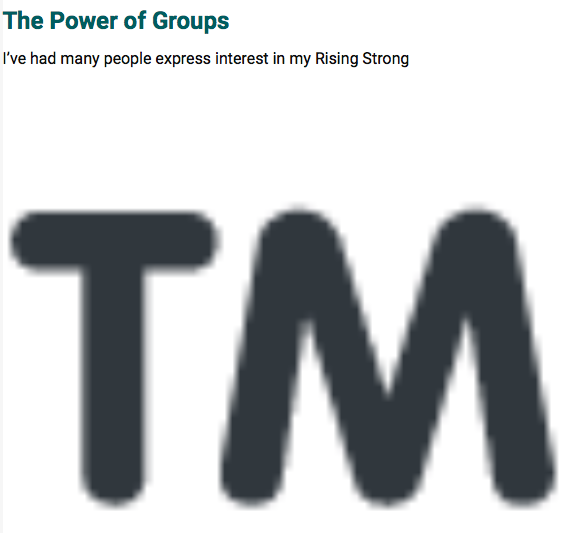Last week I sent out a new blog post about the power of groups to 500+ people with a distracting formatting error so that every time I dutifully included the trademark symbol after Daring Greatly™ and Rising Strong™, it showed up like this:
instead of like this: ™
I frantically searched for a way to unsend the sent email (which we all know is impossible), while my inner thoughts went something like this: “I’m such an idiot. What will people think? How could I mess that up so badly? I will never be good enough. My credibility is lost…”
At first glance these inner critic thoughts may sound like normal embarrassment … but at the heart of it is shame. Brené Brown says “Shame is that warm feeling that washes over us, making us feel small, flawed, and never good enough.”
I could have just given up and never published a blog post again, but instead, I put Brené Brown’s Shame Resilience Theory to work.
Brené Brown’s Shame Resilience Theory in Action
Using Brené Brown’s shame resilience theory, I was able to distance myself from those thoughts and rest in the knowledge that I am a human who made a mistake, and that small mistake doesn’t define my worthiness.
After a decade of research, Brené formulated a Shame Resilience Theory. She found that people who are able to bounce back after feeling shame share these four elements:
- They understand shame and recognize what messages and expectations trigger shame for them.
- In this instance I knew I was in shame the moment my heart dropped when I saw the email with that huge ™. I noticed the familiar pit in my stomach and heard those words creep in. I was able to identify that I have an expectation that I will only put forth my best work in the world without exception.
- They practice critical awareness by reality-checking the messages and expectations that tell us that being imperfect means being inadequate.
-
- I was able to practice critical awareness by reminding myself of the reality check that being imperfect does not mean being inadequate by remembering that even mass-produced novels sometimes have typos or grammatical errors.
- They reach out and share their stories with people they trust.
-
- I immediately shared my experience with someone whom I trust.
- They speak shame—they use the word shame, they talk about how they’re feeling, and they ask for what they need.
-
- I used the word ‘shame,’ even though like so many people, the word leaves a bad taste in my mouth and the experience of shame is pretty uncomfortable. I knew talking about it would help, and it did.
“We’re all capable of developing shame resilience. Shame resilience is the ability to recognize shame, to move through it constructively while maintaining worthiness and authenticity, and to ultimately develop more courage, compassion, and connection as a result of our experience. The first thing we need to understand about shame resilience is that the less we talk about shame, the more we have it.”
-Brené Brown
If you want to learn more about how to bounce back from shame instead of being sucked into the shame, and how to live with courage and vulnerability, take a look at my upcoming Rising Strong workshops here.

